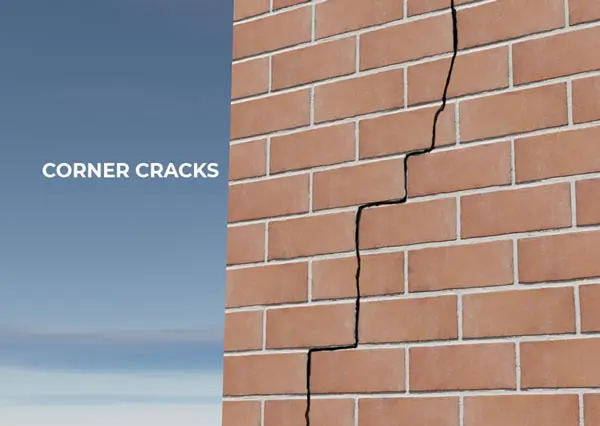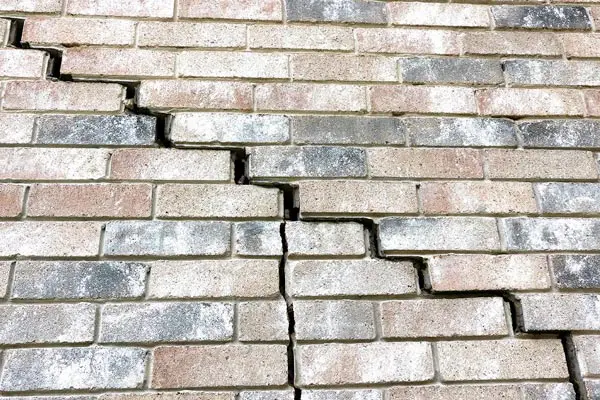Searching for information about brick wall repair? If so, you’ve landed on the right page because that’s what this article is about. We’re going to talk about the different types of cracks found in brick walls, why brick walls crack, brick wall repair, and more.
Types Of Brick Wall Cracks And What Causes Them
As homeowners, it’s essential to be aware of the different types of cracks that can occur in brick walls. These cracks not only affect the aesthetic appeal of the wall but can also compromise its structural integrity. Here are some of the common types of brick wall cracks that homeowners should know about:
Horizontal cracks
Horizontal cracks in brick walls can occur for various reasons, including poor construction methods, structural damage, and natural forces such as earthquakes and moisture.
One major factor contributing to horizontal brick wall cracks is the type of mortar used during construction. If the mortar mix is not balanced correctly, it can result in a weaker bond between the bricks, leading to horizontal cracks.
Structural damage from constant wear and tear, such as heavy traffic or construction work on adjacent buildings, can also cause horizontal cracking in brick walls. Moreover, sudden forces like seismic activity can dislodge the bricks and cause horizontal cracks.
Moisture can also be a primary culprit of horizontal brick wall cracks. When water penetrates the brick and mortar, it can weaken the wall’s structural integrity and cause horizontal cracking as it expands and contracts.
Additionally, temperature fluctuations can play a role in brick wall cracks. When temperatures change rapidly, the expansion and contraction of the materials can cause cracking.
For more information, see What Causes Horizontal Cracks In A Foundation Wall?
Vertical cracks
One of the main reasons for vertical cracks is settlement. Settlement occurs when the foundation beneath the wall shifts or sinks, causing stress on the bricks. Over time, this stress can lead to vertical cracks in the wall.
Another common cause of vertical cracks in a brick wall is expansion and contraction. This typically occurs when temperatures fluctuate drastically between hot and cold. As the bricks heat up and cool down, they expand and contract at different rates, causing cracks to form. This can also happen if the bricks have been poorly fired during manufacturing, leading to uneven expansion and contraction.
Water damage is another potential culprit for vertical cracks in a brick wall. Water penetrating the bricks can weaken the mortar and cause the bricks to shift or become loose. This can ultimately result in cracks forming in the wall.
Finally, age and wear and tear can also contribute to vertical cracks in a brick wall. Over time, exposure to the elements can cause mortar to deteriorate and bricks to weaken. This can lead to the formation of cracks in the wall.
Stair-step cracks
Potential causes of stair-step cracks in brick walls include insufficient support beneath the foundation, improper construction techniques, or a lack of proper drainage around the foundation.
The reason you see stair step cracks in the mortar lines of bricks is because that is the weakest connection point. It is easier to crack along a connection point vs. cracking through the actual brick itself.
Bulging cracks
Bulging cracks in a brick wall are typically caused by a combination of factors. One of the primary culprits is excess moisture in the bricks. When water seeps into the bricks and can’t escape, it causes them to expand, ultimately resulting in bulging or cracking in the wall.
Another factor that can contribute to bulging cracks in a brick wall is poor construction or weak mortar. If the bricks are not laid correctly, or the mortar used to hold them in place is weak or inadequate, the wall can become unstable and prone to cracking or bulging.
In some cases, bulging cracks may also result from structural issues, such as a shifting foundation or heavy loads on the wall. When the weight of the building shifts or settles, it can put pressure on the walls, causing them to crack or bulge.
Corner cracks
One of the leading causes of corner cracks is structural movement, which can be caused by changes in temperature or moisture levels. When a brick wall moves, it can cause stress on the corners, leading to cracks and possibly even collapse.

Another reason for corner cracks in a brick wall is poor construction practices. If the mortar joints are not correctly filled or the bricks are not evenly packed together, it can create weak spots in the structure that are more susceptible to cracking. Additionally, the corners may be more prone to cracking and failing if the wall is not adequately reinforced.
Environmental factors can also play a role in the development of corner cracks in a brick wall. The presence of nearby trees, vegetation, or roots can cause soil moisture fluctuations, leading to differential settlement. This can cause the wall to shift and crack at the corners. Similarly, if the wall is exposed to wind or harsh weather conditions, such as constant rain or sun exposure, it can weaken the structure and increase the likelihood of corner cracking.
Look For Other Signs – You May Have A Foundation Problem
If you notice a crack in a brick wall, look around for possible signs of a foundation problem. These include the following:
- Uneven floors
- Cracks in walls, floors, or ceilings
- Sticking doors or windows
- Visible gaps between walls and ceilings or floors
If you see any of the above or anything else that strikes you as suspicious, contact a qualified foundation repair contractor who can assess the issue and recommend an appropriate repair solution to keep your home safe and secure.
Most Cracked Brick Walls Can Be Repaired

The good news is that most brick walls can be repaired. There are different types of brick wall repair, each with unique techniques and materials.
Repointing
Repointing involves the removal of damaged or deteriorated mortar joints between the bricks and replacing them with new ones. This type of repair is necessary when the mortar joints start to crack or crumble due to weathering, age, or thermal movement. Repointing not only improves the appearance of the wall but also provides additional structural support to the wall.
Tuckpointing
Tuckpointing is another type of brick wall repair that involves a similar process to repointing but with a different technique. Tuckpointing involves two different colors of mortar to give the appearance of fine joints between the bricks, which can be visually pleasing. This technique is also used to restore the original look of the brick wall.
Brick Replacement
If a brick in the wall is severely damaged or cracked, then brick replacement will be necessary. The replacement brick should match the original brick’s size, texture, and color to ensure proper adhesion and avoid an unsightly patchwork appearance.
Brick Sealing
Another common type of brick wall repair is referred to as brick sealing. This type of repair is necessary when water damages the brick wall, especially if it’s made porous due to age or the previous use of improper sealers. A waterproof sealer is used to prevent water from penetrating the brick, which can lead to further damage and decay.
Mechanical Reinforcement
Mechanical reinforcement can also be used for brick wall repair. This technique is typically used when the wall’s structural integrity is threatened due to external factors such as earthquakes or heavy loads. The reinforcement can be in the form of steel rods or other materials inserted into the wall to increase its strength and stability.
If a brick wall on your property needs brick wall repair, contact us today to schedule an evaluation and receive a repair estimate. We serve Southern California, Arizona, and Nevada.






